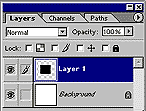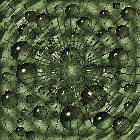




|
New
Column By
Colin Smith Quick Tips Want to use RGB Filters while working in CMYK? As you know some filters like the render filters are disabled in CMYK. Here is a neat tip, work in RGB mode with CMYK preview turned on. CTRL/CMD+Y build your file as normal then when you are finised, convert it to CMYK. This will allow all the filters to work, give you a smaller file size to work on (used 1/4 less memory) and you won't "lose" your colors when you convert it. Only use CMYK for going to a commercial printing press. Quick Fills
- Now to get really cool: To fill just the area with pixels hold down the shift key as well as above. This toggles the preserve transparency option. And
press Shift+Backspace to open the fill dialog box Quick
Color Change Web Tips JPEG (Joint Photographic Expert Group) or GIF? If the image contains large areas of solid color or simple repeating patterns, use GIF If the image is more complex in color, like a photograph use the JPEG compression. When saving as a JPEG, as a generalization never use more than 40 compression. Did you know if you apply a Gaussian blur to the image you can reduce the file size further. (I don't recommend more than 1.2 or it will affect image quality too much. Even .8 should suffice) |
Keyboard Shortcuts | |||
| Press
the [ ] keys to change the brush size. If you hold the shift key
down and go [ the brush will get softer and ] harder to a total
of 5 different levels of softness. Try it, it rocks. Works for a
bunch of tools.
Bring up the Free Transform tool - Ctrl/Cmd +T. Scale and rotate by dragging the handles. Right click (Cmd Clk Mac) and now you can do lots of cool things like skew and distort. To hide the selection - "marching ants" press Ctrl+H (Command+H) This also works to hide the highlight on the text on 6.0. Now you can preview the color of the text. To select all pixels on a layer: In the layers Palette click on the layer thumbnail while holding down the Cmd/Ctrl key  To move a selection to its own layer press CMD+J (Win Ctrl+J) This will copy it. To cut and
move a selection press Shift+Cmd+J (PC Shift+Ctrl+J) To auto-select a layer Hold down the Cmd/Ctrl key while clicking on it in the main image window |
||||
|
Selection
Tips To start drawing from the center hold the Alt/Option key Ever find that you started drawing a selection and you need to nudge it over while you are drawing it? No problem, just hold the spacebar. |
||||
|
Reset Preferences Note - you can now reset them on startup by holding down Shift+Alt+Ctrl. And of course on the Mac with Shift+Option+Command |
||||
|
Reducing
file sizes and speeding up large images, Cloning
Vat Color
Modes and formats LEGEND |
||||
|
Always
save at 72dpi for the web
|
||||
|
When doing text for the web, either use no anti alising or sharp in 6.0. If you use very small type make sure you have wide kerning (space between letters) This will make it a lot easier to read. No point in having a beautiful website if no-one can read it. One more warning. Be careful with those fancy textured backgrounds. While they may look pretty, they can make your page impossible to read, or at best difficult, and if its too much work, the surfers will go elsewhere (unless you have the formula for turning lead into gold.)
In V 6.0 you don't have to save the image, its all automatic. Slick! |
||||
| When saving in Photoshop use the Save for web option | ||||
|
LEGEND |



